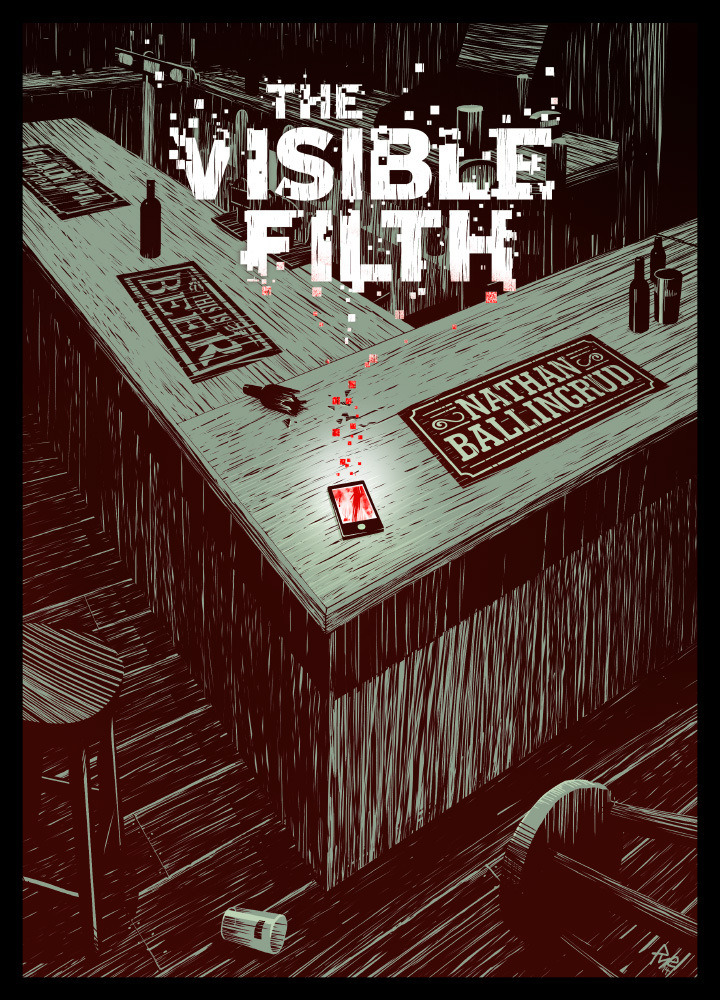Posted on May 26, 2015 by
Nick
This week on The Scariest Part, my guest is Nathan Ballingrud, who, for my money, is one of the best writers currently working in the short form of horror, fantasy, and the weird. His multiple award-nominated 2013 collection North American Lake Monsters is a must-read. His latest publication is a novella called The Visible Filth. Here’s the publisher’s description:
“Inside it’s all just worms.”
When Will discovers a cell phone after a violent brawl his life descends into a nightmare.
Affable, charismatic and a little shallow, he’s been skating across the surface of life in a state of carefully maintained contentment. He decides to keep the cell phone just until the owner returns and everything changes. Then the messages begin.
Will’s discovered something unspeakable and it’s crawling slowly into the light.
And now, let’s hear what the scariest part was for Nathan Ballingrud:
When I come to a horror story as a reader, I’m hoping to satisfy one of two cravings. One is aesthetic. If I can get a good rendering of some of the traditional trappings of the genre, I will leave sated and happy. These range anywhere from the brooding atmospherics of Stoker and his Carpathian vampire, to the Mi-Gos and their brain cylinders hiding out in Lovecraft’s rural countryside, to the baroque flourishes of Clive Barker and his Cenobites. Horror draws from a very deep well, and the possibilities here are all but inexhaustible. The other is psychological. This is the kind of horror that feels like a welcome attack, and leaves me feeling blighted and raw. The Appalachian dooms of Cormac McCarthy. The psychological vivisections of Joyce Carol Oates. This is a tougher target to hit. It’s a sniper shot versus the strafing of a machine gun. Sometimes you’re lucky and you get both, as you do in Peter Straub’s Ghost Story, or in Shirley Jackson’s The Haunting of Hill House (which is, for my money, the greatest horror novel yet written).
There are a lot of elements of aesthetic horror in The Visible Filth. You get your monsters crawling out of people’s broken heads. You get your cryptic messages from beyond. You get your cockroach swarms. I include that stuff because I love it. It satisfies the enthusiast in me, the part that would happily live in Transylvania or in Arkham, eager for a lifetime of bright, beautiful terrors. But ultimately, that’s all window dressing. For me, the real horror is psychological. Because these are the mundane horrors that we’re all subject to. They don’t carry the awful glamor of the Gothic or the surreal. They don’t leave us prostrate with holy fear. They just chew away at us with a vicious, microbial tenacity. We think we’re fine until we’re crumbling in upon ourselves.
There’s a scene in The Visible Filth, near the end, in which Will, our protagonist, is trying to break things off with Carrie, his girlfriend. (This is kind of a spoiler, I guess, but not a very serious one. It’s okay to keep reading; any story that’s worth a damn is not going to be ruined by minor spoilers.) He’s got it all planned out. He thinks he’s about to step into a wider, better life. But it doesn’t go the way he expects it to. Carrie is her own person, it turns out, and she has some ideas of her own. Nothing scary happens in this scene, other than the end of a relationship that leaves both parties wounded and a little self-hating. It’s my favorite scene in the novella, because I’ve been on both sides of that talk, and it’s awful either way. The story doesn’t end there — the big, set-piece horror ending is right around the corner — but for me, it’s the emotional heart of the story. It’s the real horror.
I’m not scared by the monsters. I’m comforted by them. Each genre offers its readers the consolations of the familiar; in horror fiction, that often means monsters, atmosphere, and threat. I’m scared by the human. I’m scared by the part of me that can’t bridge the chasm between myself and the person sitting across the table from me, who’s wondering who I am, wondering what thing it is inside me that causes me to do the things I do. As I wonder the same thing about her. I’m scared of what’s hiding in my own skull, and what might be hiding in yours.
Nathan Ballingrud: Facebook / Twitter
The Visible Filth: This Is Horror / Amazon / Barnes & Noble / Powell’s
Nathan Ballingrud is the author of North American Lake Monsters: Stories, from Small Beer Press; and The Visible Filth, a novella from This Is Horror. His work has appeared in numerous Year’s Best anthologies, and he has twice won the Shirley Jackson Award. He lives with his daughter in Asheville, NC.



